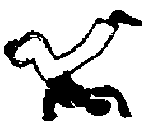

About 300 years ago, slaves in Brazil developed the martial art Capoeira. In those days the slaves exercised their techniques secretly; pretending to be dancing. Capoeira was illegal till far in the 19th century. Only after it was legalized, around 1930, Capoeira really started to develop. And it is developing still. Martial artists from other disciplines started to experiment with it too.
Capoeira sprung from different ethnical groups far away from their home countries. Maybe that's why it is so popular in the larger cosmopolitan communities: London, Tokyo, Amsterdam, Barcelona, Berlin, United States and Africa.
When two Capoeiristas meet, a 'Roda' starts. This is accompanied by singing and music from the basic instruments berimbau, pandeiro and atabaque. Within the circle, the two Capoeiristas 'play'. A third one, kneels down by the berimbau and substitutes with one of the other players.
The keywords of Capoeira are: creativity, improvise, fantasy, beauty and imagination. All this in a ritual setting. Basically, in a Roda everything is possible; it all depends on how the players play the game.
If you watch more closely, you may see a certain view on the world: react to unexpected events in life; see how a winner can be a looser (a good move, can be neutralized instantly by a counter attack).
Capoeira is acrobatic, esthetic and spectacular. Therefore both men and women feel attracted to it. As a beginner, you will need a sense of rhythm, good balance, agility and fast reflexes. But only later a Capoeirista will develop the most important qualities: modesty, observation and overcoming your own fear.